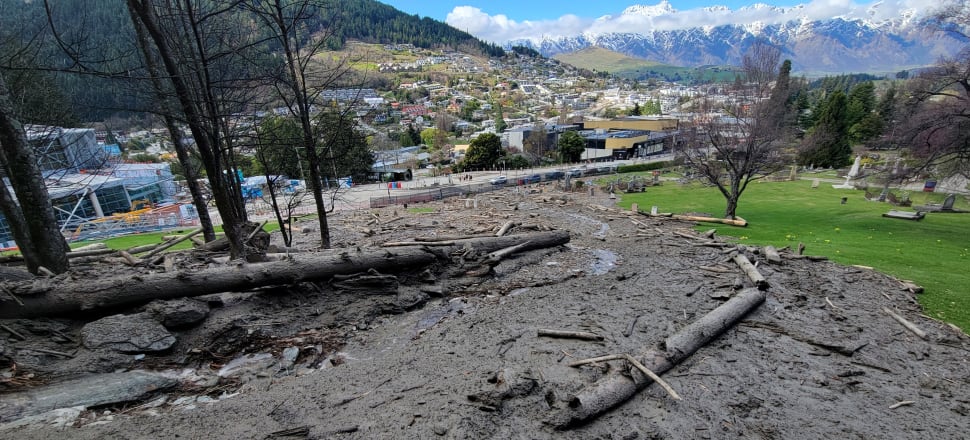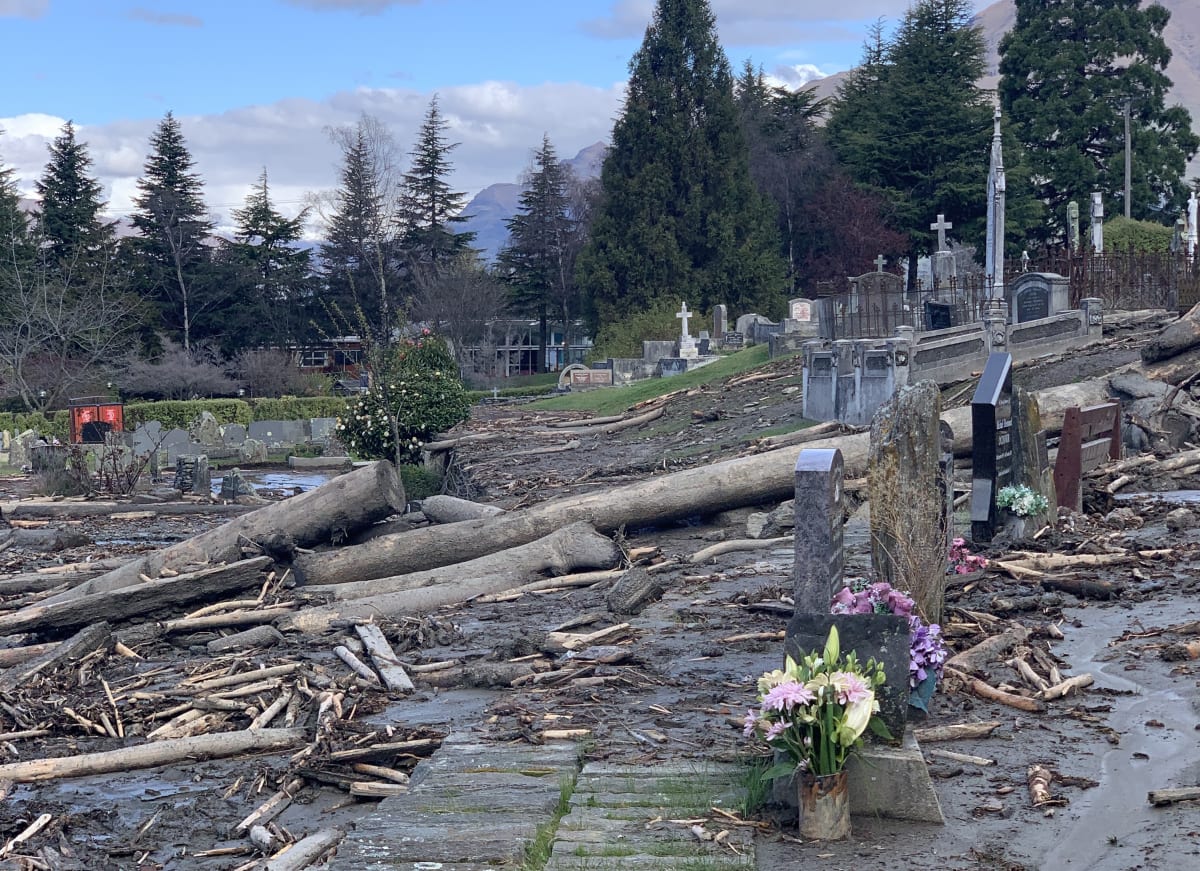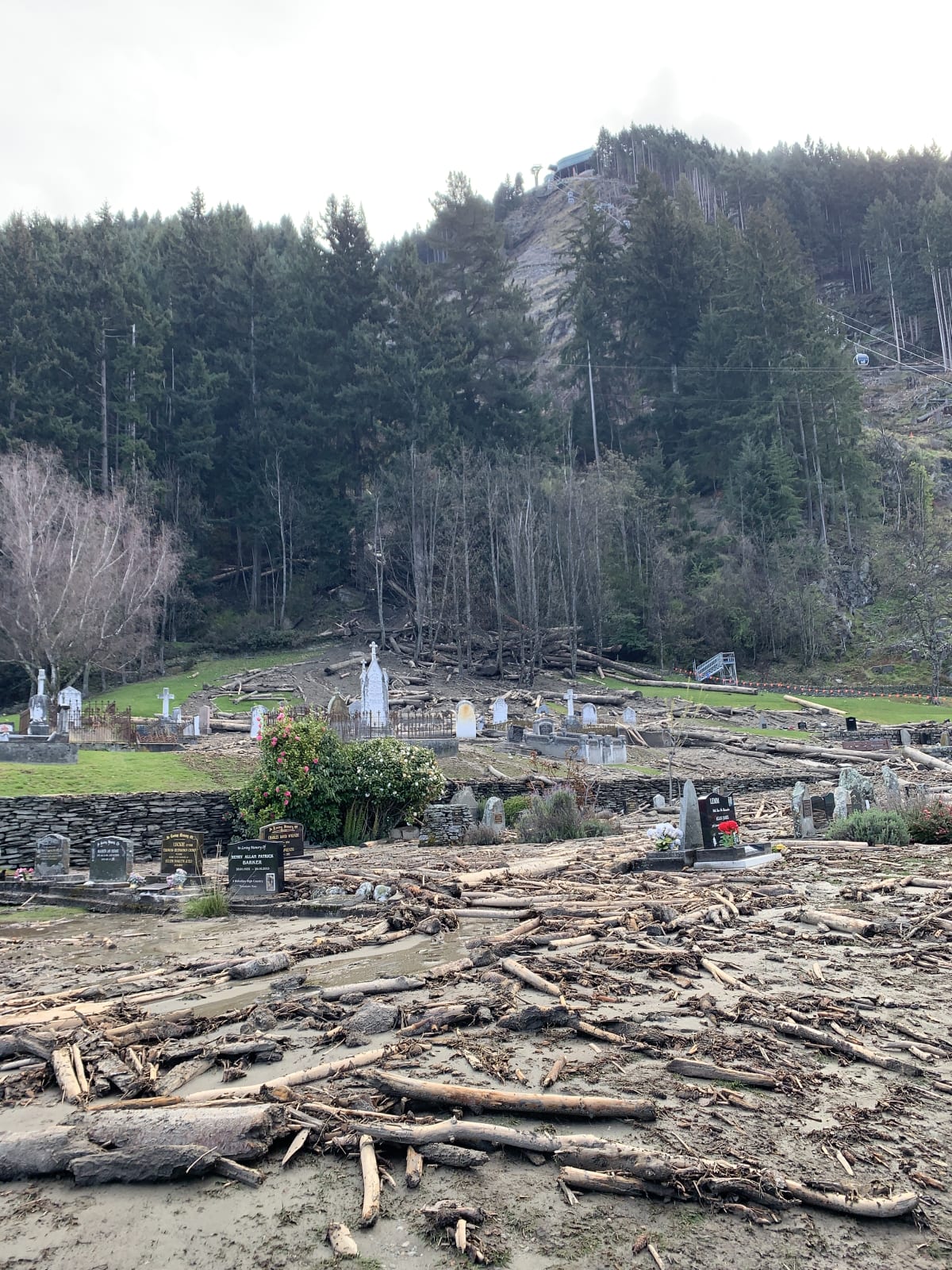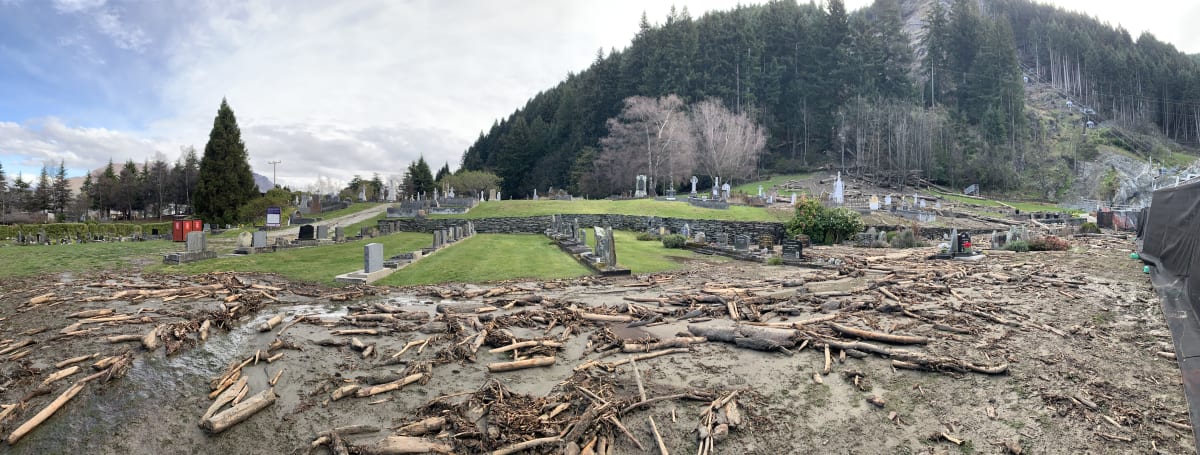
Questions asked of Queenstown’s council about tree harvesting operation
Queenstown’s council decided to leave slash in a steeply sloped forest above the tourist town’s cemetery, documents reveal.
Last week, the cemetery was inundated with mud, logs and debris after a month’s worth of rain fell in 24 hours – the wettest day since the devastating 1999 floods. Debris and flooding shut roads, and homes were evacuated, sparking a temporary state of emergency.
On Friday, Mayor Glyn Lewers told the Otago Daily Times the council would consider why large logs were stacked on the steep hill behind the cemetery, near tourism company Skyline Enterprises’ gondola cableway, once the emergency was over.
READ MORE: * Queenstown cemetery buried * Lack of water treatment highlights urgency of Three Waters reforms – mayor
According to Saturday’s ODT, Lewers said: “There has been correspondence [with Skyline] previous to this event, but we’ll wait until after we get through this initial stage and then we’ll look at how that was dealt with beforehand and afterwards.”
Skyline Gondola chief executive Geoff McDonald told the paper the stacked logs had been sitting there for a long period, waiting to be removed.
Newsroom has found 2020 consent documents for a tree-harvesting operation in Ben Lomond forest submitted by the Queenstown Lakes District Council. The council said its contractor would leave forestry slash on the unstable hill.
At the time the documents were prepared, Skyline had cleared trees to make way for its larger 10-seat gondola cabins.
The council’s planned harvest, covering 1.5 hectares of steep slopes west of the gondola cables, was done out of fears newly exposed trees were at risk of blowing over in high winds.
(In planning parlance the council’s application was an “outline plan” sitting outside Queenstown’s district plan rules because the land in question, the Ben Lomond Scenic Reserve, was designated for forestry operations. The council is a “requiring authority” applying to itself for approval. The application was considered by an independent commissioner.)

An assessment of environmental effects for the forestry work said all logs exceeding 3.9m in length and 20cm diameter at the “small end” would be recovered for sale.
“As well as leaving the smaller un-saleable logs within the forestry canopy, the council will ensure that all the associated slash that can be retrieved safely, will be removed and deposited within the new forest edge out of view from the wider Queenstown area,” the report said.
“In some cases, there will be slash left on site due to access around bluffs, some of the slash will not be able to be retrieved and will be left on the site to break down.”
The instability of the forested slopes was raised in a rockfall hazard assessment, completed by consultancy GeoSolve. Two particular “bluffs”, or cliffs, had unstable features – so much so the likelihood of rock falls during tree harvest was “almost certain”.
“A large historical rock fall debris fan has been identified within the site, extending down the majority of the site from the toe of bluff 27 to base of the slope at the boundary with the Queenstown Cemetery.”
Before the council-commissioned harvest, GeoSolve recommended mitigation measures, including removing or stabilising boulders, installing mesh over bluffs, and building catch fences or barriers, and catch benches.

A hazard identification, risk assessment and controls report, done for the council, raised concerns about water run-off. It said run-off channels, culverts, and sediment traps should be installed, and run-offs should be built at the rear of all skids/landings.
GeoSolve’s report contained pictures of slash from Skyline’s tree removals.
The report also stated: “Some rock fall debris below bluffs 17 and 24 is thought to be brought down by recent tree removal works as part of the Skyline gondola upgrade.
“Accumulation of debris can extend tens of metres downslope, in some case fallen rocks have come to rest approximately 100m downslope from their inferred source location.”
The report identified a 2.5m-wide, 3m-high boulder. “The likelihood of this falling during tree removal works is considered almost certain.”
Newsroom asked Lewers, the Queenstown mayor, about the council’s tree removal work. He said: “I’m unfamiliar with that plan so I wouldn’t be able to speak about it with any confidence.”
We sent questions to the council’s communications staff yesterday. They included:
- Was the slash that flowed into the cemetery associated with this work?
- Was risk remediation work inspected and approved by QLDC, at the time?
- After the tree removal work, was an assessment of the long-term rock fall risk completed?
An anonymised council response said: “We acknowledge the questions you have raised, however at this time we are still working through such matters.”
The council statement also said: “QLDC is currently transitioning from emergency response to recovery following the significant weather event that has impacted the town and the reserve.
“QLDC is working with all stakeholders on Ben Lomond to ensure safety for all concerned and working through the steps needed as part of the transition process Mayor Lewers declared yesterday.
“Those transition steps include: the need to mitigate, manage, monitor and assess the safety on the Ben Lomond Reserve, adjoining reserves, public interface and leaseholder areas impacted by the 22nd September weather event.”

Once the council is prepared to answer questions, it will be interesting to find out if it was warned about the potential for slips in such an erosion-prone area. Previous logging operations have involved helicopters, so the council might want to explain why this harvest was purely land-based.
Queenstown is one of the country’s fastest-growing areas.
High house prices and rents have been an ongoing headache but the situation’s been exacerbated after Covid-19 lockdowns, with businesses struggling to find accommodation for staff.
The district has a relatively small population base and, unfortunately, ratepayers are saddled with having to pay for infrastructure to cope with huge volumes of tourists.
It doesn’t always keep up. Some would say an example is the failure to install a protozoa barrier at its Two Mile water treatment plan, which could have avoided a recent cryptosporidiosis outbreak.
But in terms of symbolism, you can’t get much worse than mud, rocks and logs spewing across a cemetery – especially as problems with slash have been so apparent on the North Island’s east coast in recent years.
On Saturday, the council said restoration work at Queenstown Cemetery would be a priority in the post-slip clean-up. About a third of the cemetery had been affected, with some headstones displaced, but there was no below-ground disturbance visible, the council said.







